Key takeaways
- HDR photography captures a wider range of highlights and shadows, enhancing emotional depth in wedding images.
- The technique allows photographers to balance challenging lighting conditions, preserving detail and vibrancy in photos.
- Learning to use HDR in editing software like Lightroom can transform images and evoke strong emotional responses from clients.
- Careful attention to post-processing is essential to maintain natural beauty while avoiding overly vibrant or unrealistic outcomes.
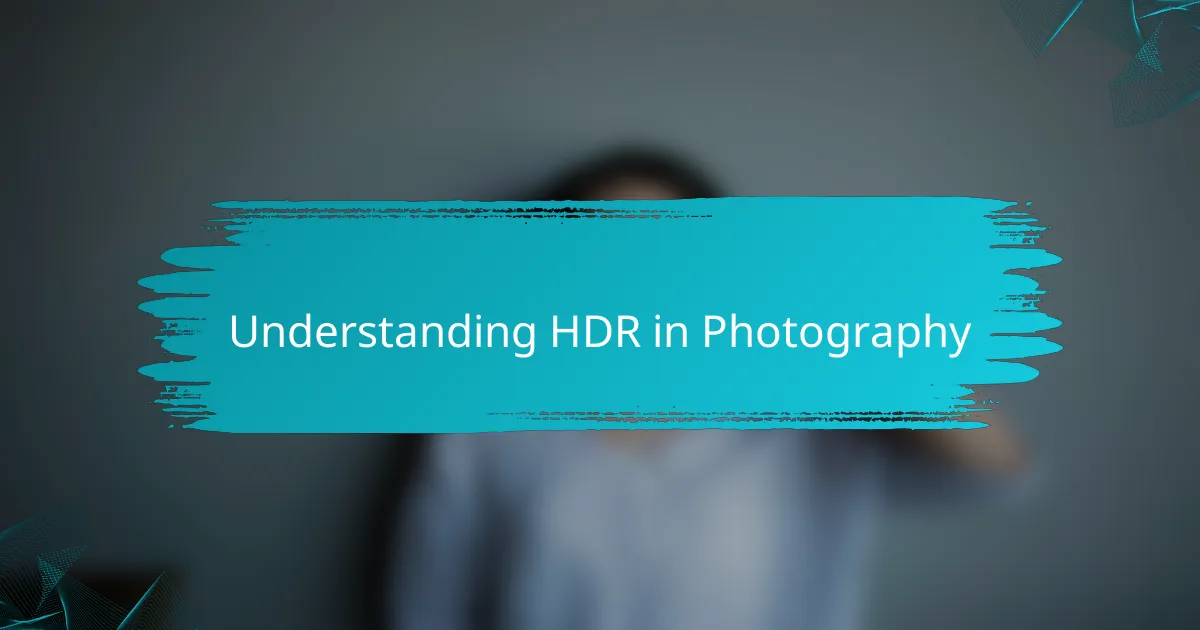
Understanding HDR in Photography
HDR, or High Dynamic Range, is a technique that involves capturing and combining multiple exposures of the same scene. As I started exploring HDR, I was fascinated by how it allowed me to capture details in both highlights and shadows, something that traditional photography struggled to achieve, especially in dynamic environments like weddings. Have you ever looked at a photo and felt like something was missing? That’s where HDR excels—bringing those vibrant moments to life.
When I first experienced HDR, it felt like unlocking a new level in my photography. The colors became more vivid, and the details more refined, turning ordinary wedding scenes into extraordinary memories. I remember a particularly overcast day where the lighting was challenging. Using HDR, I managed to capture the couple under a moody sky while ensuring the love and joy in their expressions truly shone through.
The process of merging exposures can seem daunting at first, but it becomes a delightful part of the creative journey. I often find myself asking, “How can I elevate this moment?” As I learned the nuances of HDR in Lightroom, I began to understand that the real magic lies in balancing the tones, allowing me to express the emotions of the day in ways that resonate with the viewer.
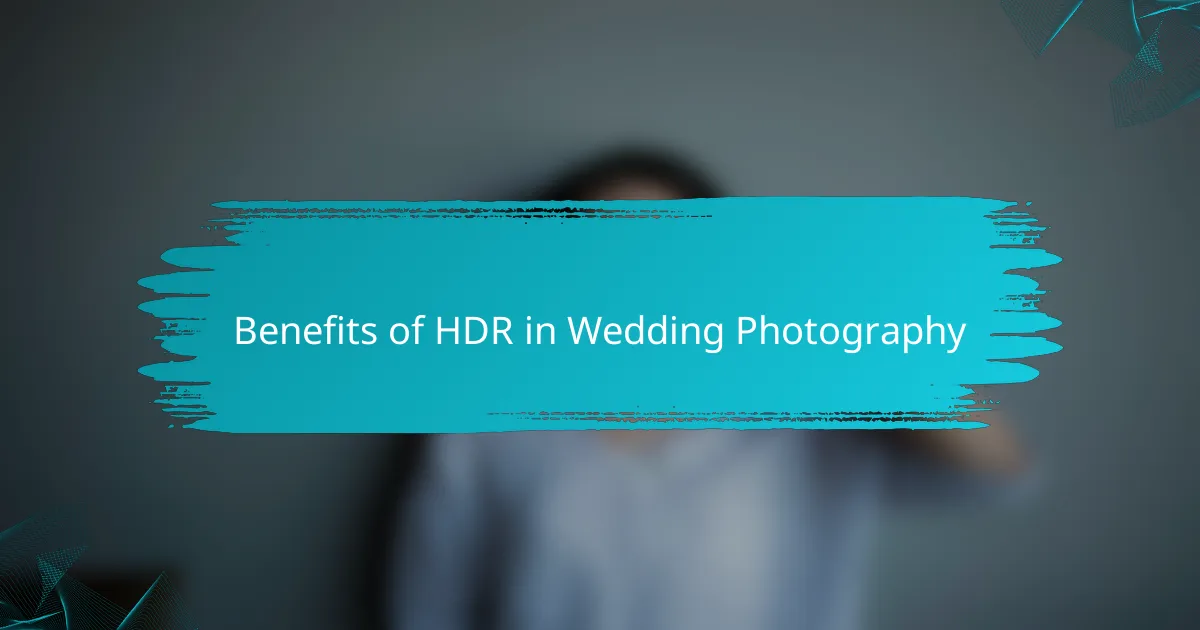
Benefits of HDR in Wedding Photography
Using HDR in wedding photography offers a vibrant way to capture the emotional depth of the day. I’ve found that it beautifully balances highlights and shadows, especially in challenging lighting conditions. For instance, during a late afternoon ceremony, the HDR technique allowed me to bring out the intricate details of the bride’s dress while keeping the background soft and romantic, creating a captivating atmosphere.
One of the biggest benefits of HDR is its ability to enhance detail in both bright and dark areas. This is crucial for wedding shots, where you want to preserve the brightness of sunny outdoor scenes while highlighting the subtle tones in the wedding party’s attire. I’ve genuinely seen my clients’ faces light up when they see their wedding photos looking so stunningly vibrant and real.
When comparing traditional photography techniques to HDR, the differences are striking. Traditional photography can sometimes lead to blown-out highlights or lost details in shadows, while HDR maintains detail across the board, providing a more immersive experience.
| Feature | Traditional Photography | HDR Photography |
|---|---|---|
| Dynamic Range | Limited | Extended, capturing more details |
| Color Depth | Standard | Enhanced, more vibrant |
| Light Handling | Can struggle in challenging light | Balances shadows and highlights well |
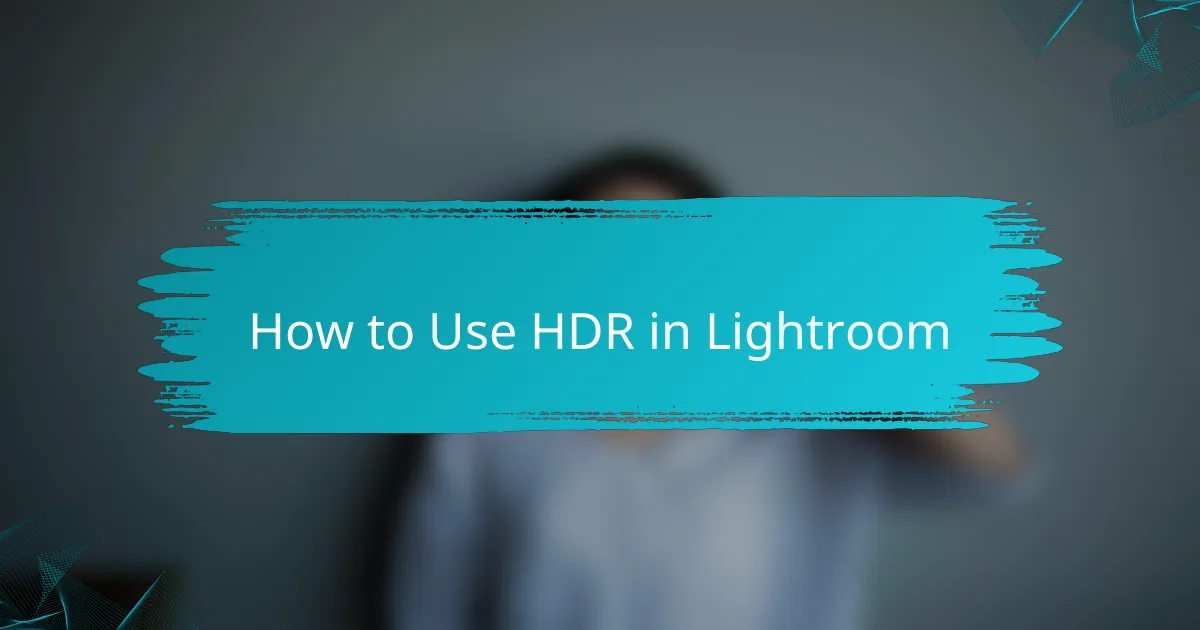
How to Use HDR in Lightroom
Using HDR in Lightroom can truly transform your wedding photography. I remember the first time I applied it to a couple’s outdoor ceremony; the vibrant colors and dynamic range brought their special day to life in ways I hadn’t imagined. It allowed me to balance the shadows and highlights perfectly, capturing every detail of their smiles under the afternoon sun.
When you’re ready to use HDR in Lightroom, follow these simple steps for effective results:
- Import your bracketed images into Lightroom.
- Select the photos you want to merge.
- Right-click and choose “Photo Merge” followed by “HDR.”
- Adjust the preview sliders for deghosting and settings like White Balance and Exposure as needed.
- Click “Merge” to create a single HDR photo that combines all the tonal ranges.
- Fine-tune the resulting image with basic adjustments to enhance colors or contrast.
In my experience, this process not only enhances the images but also evokes the emotions of the day, allowing couples to relive their wedding moment in stunning detail.
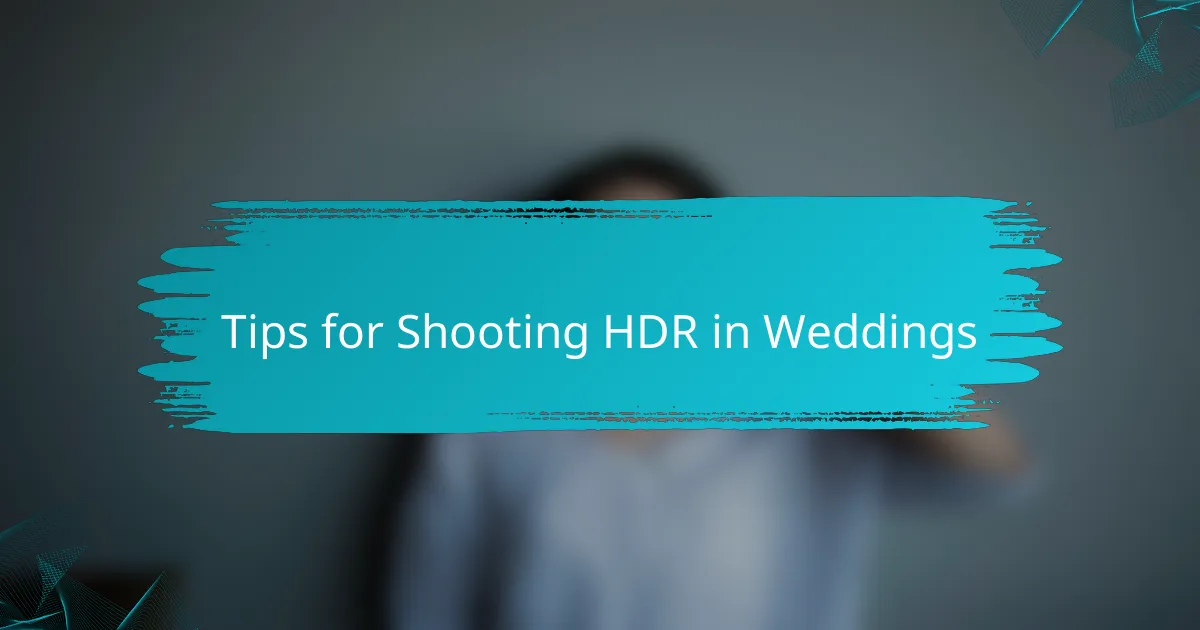
Tips for Shooting HDR in Weddings
When capturing weddings, I find that shooting HDR can beautifully highlight the emotional nuances of the day. For instance, during a sunset ceremony, I took multiple exposures to ensure the vibrant colors of the sky complemented the joyous expressions on the couple’s faces. This technique allowed me to create a stunning visual narrative, making the moments even more memorable.
Here are some practical tips for shooting HDR during weddings:
- Use a tripod: It helps maintain consistent framing across exposures, which is crucial for a polished final image.
- Choose the right moments: Look for high-contrast situations, like a couple under a tree or against a bright backdrop, to truly showcase the HDR effect.
- Bracketing is key: Capture at least three different exposures (underexposed, correctly exposed, and overexposed) for better results.
- Stay steady: If you’re shooting handheld, find a steady base and use a fast shutter speed to minimize motion blur between frames.
- Edit with care: Post-processing is vital for HDR; too much adjustment can lead to unnatural images, so aim for a balanced look that enhances the moment.
Utilizing these tips has deeply enriched my photography; it has turned ordinary moments into breathtaking memories that couples cherish forever.
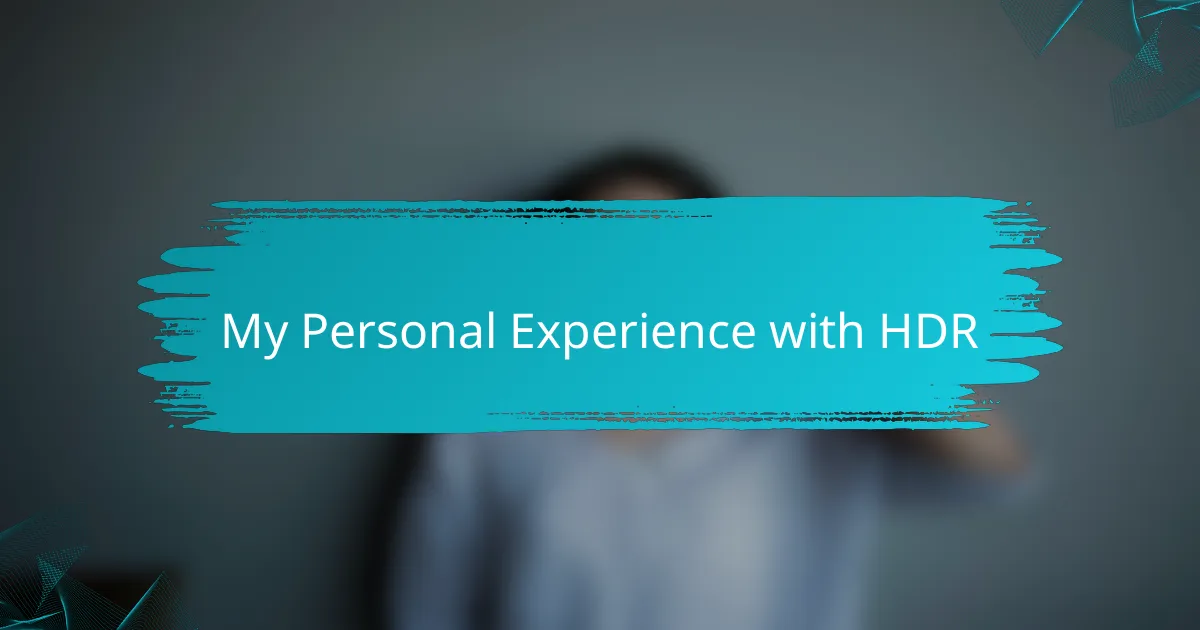
My Personal Experience with HDR
When I first ventured into using HDR (High Dynamic Range) in Lightroom, I was both excited and a bit intimidated. I remember capturing a stunning sunset during a wedding; the colors were vibrant, but the contrast between the sky and the couple was challenging. By applying HDR, I was able to balance the highlights of the sunset with the delicate details of their expressions, creating a breathtaking image that perfectly encapsulated that magical moment.
As I grew more comfortable with HDR techniques, I began experimenting with the tone mapping settings to achieve different artistic effects. I found that subtle adjustments could enhance the atmosphere of a scene, transforming an ordinary shot into something truly special. It’s rewarding to witness how HDR can breathe life into wedding images, preserving the emotional depth and memory of the day.
- HDR allows for stunning detail in both shadows and highlights.
- It captures the full range of light in dynamic scenes, perfect for wedding photography.
- I often find that HDR highlights emotions that might otherwise be lost in high-contrast situations.
- Experimenting with HDR has helped me develop a unique style in my wedding photography.
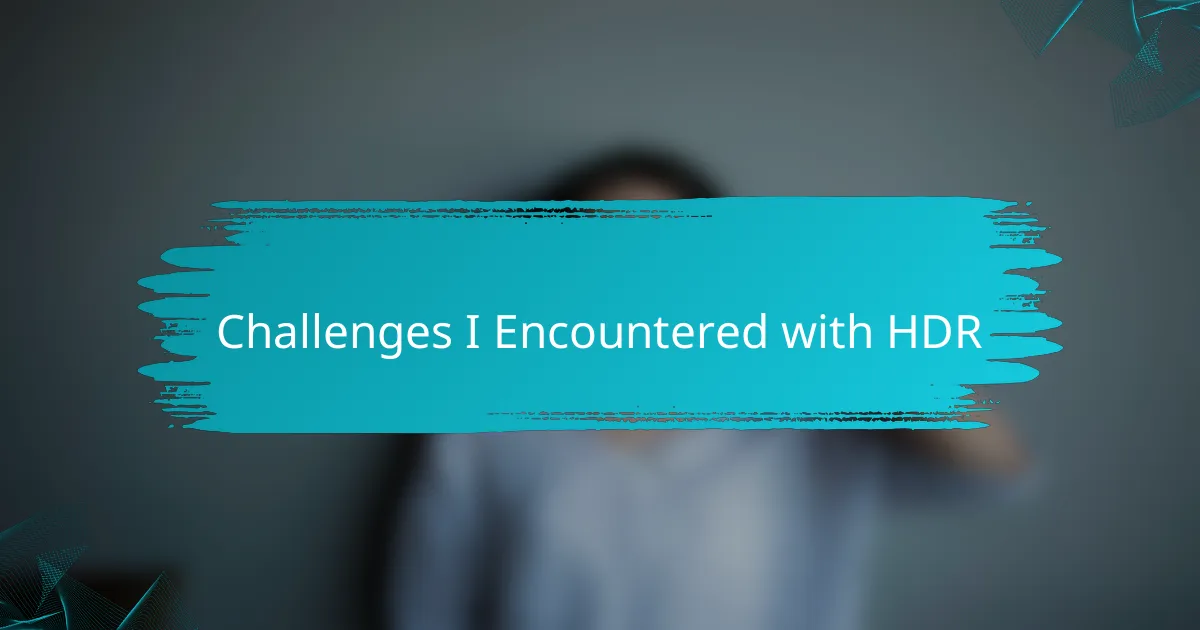
Challenges I Encountered with HDR
When I first started using HDR, I faced challenges that made me pause and rethink my approach. One significant hurdle was the careful balancing of exposure when I had both bright outdoor scenes and darker indoor moments. I remember a wedding reception where the lighting shifted dramatically as the sun set. It pushed my limits because I needed to ensure that the details in the couple’s faces were preserved while still allowing the beautiful, twinkling lights in the background to shine through.
Another issue was the potential for unrealistic images if I wasn’t careful with my editing. I recall processing one image where the colors became overly vibrant, almost cartoonish. It was a valuable lesson for me in moderation. With HDR, it’s easy to get carried away and lose the natural beauty of the moment. How do you find the right balance? I learned that sometimes less is more; retaining the authenticity of the moment should always be the priority.
Dealing with artifacts and ghosting from moving subjects also posed a challenge. During one memorable ceremony, the couple’s little niece couldn’t stay still and ended up blurred in several frames. I found myself needing to re-evaluate my approach and embrace the fact that not every HDR shot would be flawless. It taught me resilience and creativity, ultimately making me a better photographer as I adapted to the circumstances of a busy wedding day.
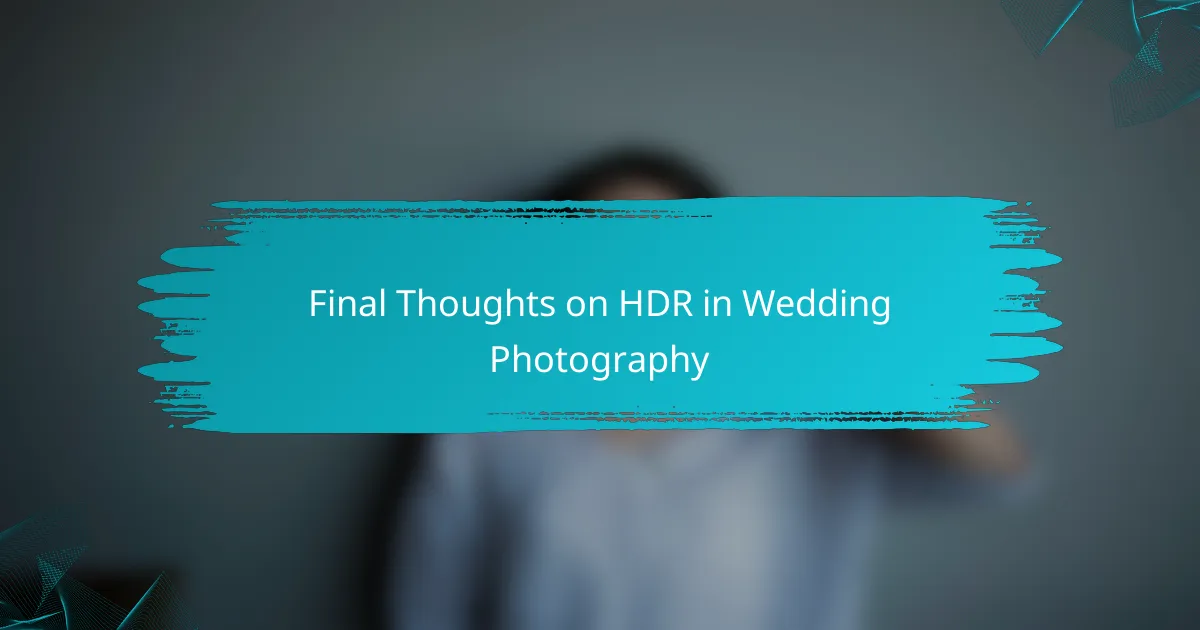
Final Thoughts on HDR in Wedding Photography
The journey with HDR in wedding photography has been nothing short of transformative for me. I’ve realized that it’s not just about enhancing images; it’s about capturing the essence of those fleeting moments. After witnessing a bride’s emotional reaction as she saw her wedding photos brought to life with HDR, I knew that this technique could truly tell a story—one that resonates with joy and nostalgia.
There’s a delicate balance that comes into play when using HDR, especially in high-stakes environments like weddings. I often find myself asking, “How can I maintain the emotional authenticity of the moment while still showcasing the beauty of the scene?” This introspection has shaped my approach, reminding me that techniques are tools, not crutches. Each image is an opportunity to reflect the couple’s unique journey while preserving the raw emotions of the day.
In my experience, the beauty of HDR lies in its ability to transport viewers back to those cherished moments. I vividly remember a couple sharing their vows bathed in late afternoon light; the HDR process allowed me to immortalize each expression and detail. It’s these realizations that make me passionate about integrating HDR into my work, ultimately enriching the stories I capture in my photography.
